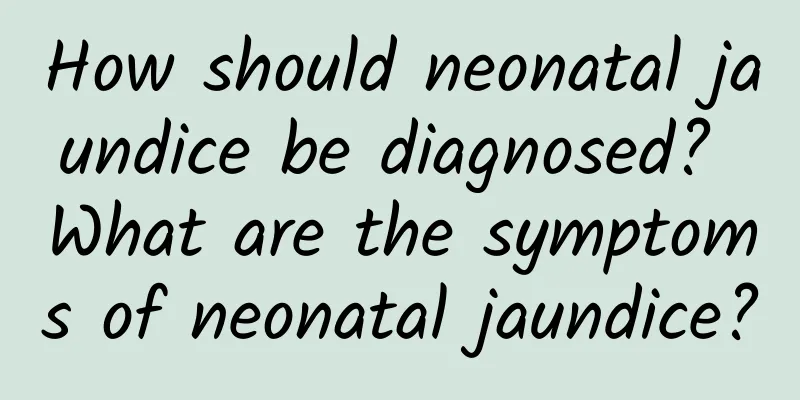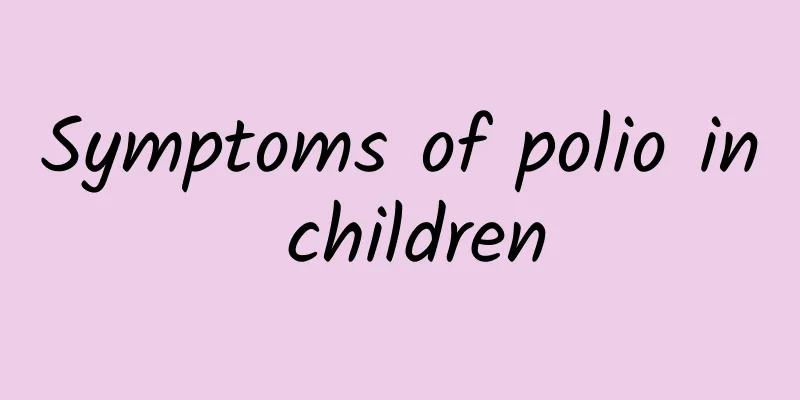How should neonatal jaundice be diagnosed? What are the symptoms of neonatal jaundice?

|
1. General symptoms and signs Clinical features of cholestasis may include intrauterine growth failure, premature birth, feeding difficulties, vomiting, slow growth, and partial or intermittent bile-deficient stools (white stools). Jaundice can be seen in the neonatal period, but it is often delayed to 2 to 3 weeks. The urine is dark and will stain the diaper, and the stool is often light yellow, light brown yellow, gray or white. The exudation of bilirubin products around the intestinal mucosa often makes the stool slightly yellow. Hepatomegaly is very common, and the liver feels hard to varying degrees on palpation; splenomegaly will appear later. Older children may have itching, clubbed fingers (toes), xanthomas, and rickets beads. Heart murmurs can be heard throughout the precordial area or back, reflecting increased cardiovascular output or shunting through bronchial arteries. By 2 to 6 months, the growth curve reflects little weight gain, which may be the result of fat malabsorption and increased oxygen consumption. Complications such as ascites and bleeding appear later. Jaundice usually occurs 2 weeks after birth and gradually worsens. But it can also be as late as 2 to 3 months. Loss of appetite, weakened sucking reflex, lethargy, and vomiting often occur. Moles, papules, or petechiae may appear. In milder cases, slow growth may be the only symptom. Occasionally, liver failure, thrombocytopenia, edema (non-hemolytic edema), and neonatal hemorrhagic disease may be seen. 2. Neonatal hepatitis B virus infection Neonatal hepatitis caused by HBV has various manifestations. If measures are not taken to prevent infection (such as the use of HBIG or vaccines), 70% to 90% of infants born to HBsAg-positive mothers will be infected with HBV at birth. Most infants infected will become HBV carriers, usually for life. Subacute severe hepatitis is rarely reported, especially in those infected through infected blood during or after delivery. However, it can also occur in cases of viral infection transmitted by the mother. Such cases are mainly clinically manifested as progressive jaundice, coma, liver shrinkage and abnormal coagulation function. Respiratory, circulatory and renal failure follow. Histologically, the liver shows large areas of liver necrosis, reticular structure destruction, micro-inflammation, and occasional pseudolobule formation. It is reported that a few survivors have reconstructed liver structure and are close to normal. In a few severe cases, focal hepatocellular necrosis with mild portal inflammation may be seen. Cholestasis is intracellular and tubular. Chronic persistent and chronic active hepatitis may persist for several years, with persistent antigenemia (HBsAg) and mild elevations of transaminases. Chronic active hepatitis may develop into cirrhosis within 1 to 2 years. 3. Neonatal bacterial hepatitis Most neonatal bacterial liver infections are acquired due to amnionitis caused by the upward spread of maternal birth canal or cervical infection, which invades the placenta. The onset is acute, usually 40 to 72 hours after birth, with symptoms of sepsis and common shock. Jaundice may occur in less than 25% of cases, but it occurs earlier and presents mixed jaundice. The liver enlarges rapidly, and histological changes show extensive hepatitis, with or without small or large abscesses. The most common pathogens are Escherichia coli, Listeria, and Group B Streptococcus, and rarely rod-shaped Mycobacterium tuberculosis. Isolated liver abscesses caused by Escherichia coli and Staphylococcus aureus are often associated with omphalitis and umbilical vein catheterization. Bacterial hepatitis and neonatal liver abscesses require large doses of specific antibiotics, and a few cases require surgical drainage. Death is common, but surviving cases do not have long-term sequelae of liver disease. 4. Cytomegalovirus (CMV) CMV infection is quite common in my country, mainly causing respiratory symptoms and cholestasis. The diagnosis is based on the detection of CMV (including CMV antigen or DNA) in the urine or secretions of the sick child, or positive serum CMV IgM. CMV IgG antibody positivity cannot be diagnosed as CMV infection because it can be from the mother, unless the titer of the double serum increases by 4 times, or the titer is higher than the mother at 2 months. 5. α1-antitrypsin (α1-AT) deficiency This disease is an autosomal dominant inheritance and can cause cholestasis. It usually occurs within 3 months after birth and is accompanied by abnormal liver function. Jaundice can disappear naturally around 8 months, but most develop into cirrhosis after 5 years of age. 6. Neonatal jaundice with urinary tract infection Infected infants are usually male, and jaundice usually occurs in the 2nd to 4th week after birth. Manifestations include lethargy, fever, loss of appetite, jaundice, and hepatomegaly. Except for mixed hyperbilirubinemia, other liver function changes are not obvious. There may be leukocytosis, and bacterial culture can confirm the infectious agent. The mechanism of liver function damage is unclear, and it was once thought to be related to the toxic effects of bacterial products (endotoxins) and inflammatory responses. Treatment of the infection can quickly eliminate cholestasis without liver sequelae. Metabolic liver disease can coexist with Gram-negative bacterial urinary tract infection, and attention should be paid. 7. Intrahepatic bile duct dysplasia is characterized by persistent jaundice, bile-free stool, and significantly elevated levels of bile acid and cholesterol in the blood, the latter of which can be as high as 14.3-26.0 mmol/L (550-1000 mg/dl). Skin itching and xanthomas may occur. ALT is slightly elevated, and alkaline phosphatase is significantly elevated. Liver histological changes show that interlobular bile ducts are significantly scarce. This disease can be divided into two types: (1) Alagille-Watson syndrome: also known as arterio-hepatic dysplasia. In addition to cholestasis, it also has a special facial appearance (broad forehead, pointed chin, sunken eyes, wide eye distance), juvenile corneal arches, and often vertebral deformities, such as butterfly vertebrae, hemivertebrae, and unfused anterior arches. Among cardiovascular abnormalities, pulmonary artery stenosis is the most common, and aortic coarctation is occasionally seen. This type has a good prognosis and rarely develops into cirrhosis. (2) Asymptomatic type: There are no symptoms mentioned above, and it is difficult to distinguish clinically from biliary atresia and idiopathic infantile hepatitis. The prognosis is poor, and it progressively develops into cirrhosis. The diagnosis mainly relies on liver biopsy. 8. Inspissated bile syndrome: The bile duct is blocked by thick mucus or bile. It usually occurs after severe hemolytic disease of the newborn. The symptoms are difficult to distinguish from biliary atresia. Some children may recover naturally or after treatment with phenobarbital. Some require surgical lavage. 9. Children with congenital biliary atresia are generally well at birth and have normal weight. Meconium is also normal. Persistent jaundice usually occurs 1 to 2 weeks after birth. The stool is light in color, even grayish white. The urine is dark in color and bilirubin is positive. This disease occurs more often in girls than in boys, and may be accompanied by polysplenia syndrome, abdominal visceral transposition, intestinal malrotation, right heart and intra-abdominal vascular malformations. When the jaundice is severe, the stool of the sick child may be light yellow. However, if the stool is very yellow or green, this disease can be excluded. The liver is progressively enlarged, and often involves the left and right lobes of the liver; after a few weeks, the spleen of most sick children gradually enlarges. Blood alkaline phosphatase, 5-nucleotidase and low-density lipoprotein (lipoproteinX, Lp-X) increase significantly. B-ultrasound examination can reveal the absence or dysplasia of the gallbladder. 10. Other extrahepatic bile duct diseases Choledochal cysts can sometimes be palpated in the right upper abdomen. In younger infants, it can cause complete obstruction of the common bile duct, and the clinical manifestations are similar to biliary atresia. Ultrasound examination is easy to identify. Cholelithiasis is rare in infants, and the incidence is increased in infants who have been receiving intravenous hypernutrition for a long time and in infants with neonatal hemolytic disease. Ultrasound examination is helpful for diagnosis. Cholestasis accompanied by progressive abdominal distension and yellowing of the umbilicus and groin skin should be considered as spontaneous perforation of the common bile duct. The presence of bile in the ascites supports the diagnosis. Children with hereditary metabolic diseases often have various deformities. Vertebral arch defects include fusion of the vertebral body or anterior vertebral arch (butterfly deformity) and reduced distance between the pedicles of the thoracic and lumbar spine. Eye deformities (congenital corneal opacities) and kidney deformities (renal maldevelopment, tubular dilatation, single kidney and hematuria). Growth retardation, usually low IQ, hypogonadism and micropenis may occur. Weak and shrill voice. Neurological abnormalities (reflexia, ataxia, ophthalmoplegia) may occur. Accompanied by polysplenic syndrome, abdominal visceral translocation, intestinal malrotation, dextrocardia and intra-abdominal vascular malformations. Neonatal lupus erythematosus may be associated with giant cell hepatitis; thrombocytopenia, rash, or congenital heart block are common. The diagnosis can be confirmed based on clinical manifestations and laboratory tests, but the etiology must also be determined. The patient's medical history must be carefully inquired, including the mother's pregnancy history, birth history, feeding history, etc. A detailed physical examination, laboratory tests and auxiliary tests must be selected to make a clear etiology diagnosis as soon as possible. |
Recommend
What to do if your child coughs
Young children are prone to coughing because of t...
How to reduce the fever caused by hand, foot and mouth disease? How to reduce the fever caused by hand, foot and mouth disease?
Hand, foot and mouth disease is a relatively comm...
What are the precautions for polio patients?
Poliomyelitis is also known as poliomyelitis. In ...
Causes of Kidney Disease in Children
Many studies have shown that the incidence of kid...
Why does the baby cough while feeding?
If a baby coughs while feeding, it may be due to ...
What should patients with Kawasaki disease eat?
Once our children become ill, parents will be ver...
Drugs for treating pneumonia in children
Nowadays, pediatric pneumonia seriously torments ...
Can baby hernia be cured?
When a baby has a hernia, it is very painful. If ...
What are the hazards of excessive jaundice in newborns?
Excessive neonatal jaundice may cause acute bilir...
What are the symptoms of ADHD in children?
Children with ADHD usually show the following mai...
Why do newborns have physiological jaundice?
The symptoms of jaundice are yellowing of the ski...
Treatment of diarrhea in children in China
The causes of pediatric diarrhea are relatively c...
What are the tests for mumps?
The incidence of mumps is increasing year by year...
Can a two-month-old baby drink Yitanjing?
If a two-month-old baby coughs, he can drink Itan...
What is the cause of polio?
After suffering from polio, many parents are not ...









